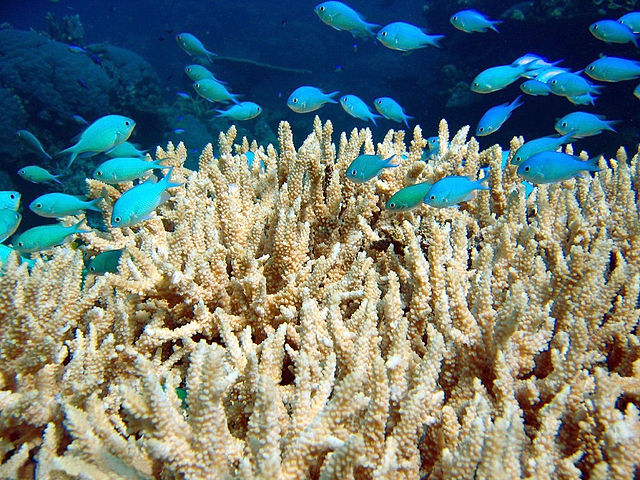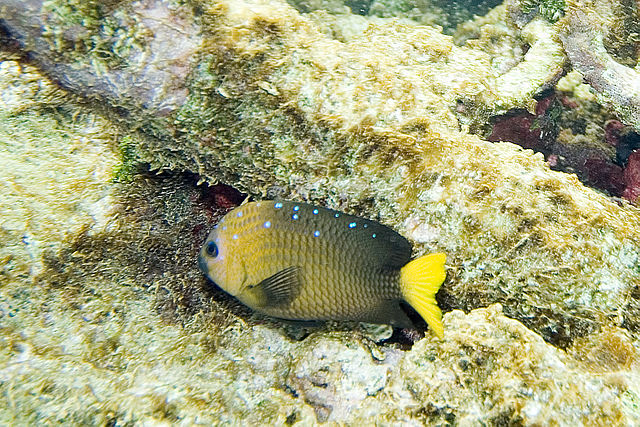Damselfish are a beautiful species that can add life and colour to your aquarium.
However, while they’re relatively simple to care for, it’s important to know the breeds to select from and what unique advantages or challenges they’ll each present.

Interested in owning one for yourself? Here we break down all you need to know before deciding if they’re the right pet for you.
Contents
Damselfish Personality And Appearance
Damselfish are a omnivorous saltwater fish species that belong to the family Pomacentridae.
In the wild, they mostly feed on plankton and are a coral reef-dwelling species, related to clownfish. Some members of this family are called chromis, but they are still grouped under the term ‘damselfish.’
Many damselfish species are popular fish for beginning marine aquarists.
They are hardy, most tend to stay under 3.9 inches (9.9 cm) long, and they are easy to feed.
Some species are peaceful and get along easily with other fish in a marine tank, while others are highly aggressive and are not recommended to be kept with other fish.
They tend to be brightly coloured and add great visual interest to a tank.
They generally live to be about four to six years old in the wild, but can live up to 15 years in captivity with proper care.
Types of Damselfish
There are several different types of damselfish, from the highly aggressive blue devil damselfish to the generally peaceful Talbot’s damselfish, and many others.
This guide will focus on some of the more peaceful species, which should adjust to life in your tank easily.
Yellow Tail Damselfish
Yellow tail damselfish are mostly blue, with a patch of yellow on and around their tails. They are native to the Indo-Pacific region and grow up to three inches (7.62 cm) long.
They can be moderately aggressive to other fish in your tank, but their aggression will be lessened if you keep them in groups of three to seven.
They inhabit the middle to bottom of a tank, and prefer to have a sand substrate to burrow in.
Azure Damselfish
Azure damselfish look similar to yellow tail damselfish, but they have more yellow on their bodies; they are about half blue and half yellow.

They are also native to the Indo-Pacific region. They can grow up to 2.75 inches (6.99 cm) long.
They are less aggressive than yellow tail damselfish, but may still be aggressive to other fish if they feel their territory is being encroached on.
They inhabit the middle to bottom of a tank, and enjoy both hiding in crevices and swimming out in the open.
Some keepers recommend keeping yellow tail damselfish or azure damselfish in an odd-numbered group, unless you have a tank that only houses a mated pair and no other fish.
Mated pairs can become very territorial and aggressive to other fish.
Blue-Green Chromis
The blue-green chromis is a peaceful schooling fish that is highly recommended for amateur keepers. They range in colour from a light blue to a light green.
They are native to the Indo-Pacific region. They can grow up to 3.75 inches (9.53 cm) long, although you are not likely to see one grow to more than 3.5 inches (8.89 cm) long.

They are highly social and need to be kept in a group of at least six – the more the better (given enough space) – or else the higher ranking ones will attack the lower ranking ones.
They inhabit the middle to top of a tank.
Damselfish Tankmates
Damselfish can make good tankmates to peaceful fish such as gobies, dartfish, and fairy wrasses, as long as there is ample space for all your fish. Also make sure the peaceful fish are established in your tank first.
If you house them with small semi-aggressive or aggressive fish, they should be monitored closely to make sure that they are not being bullied.
You should use a large tank of at least 100 gallons (378.5 liters) so that your damselfish can establish their own territory.
Do not house them with large semi-aggressive or aggressive fish, as the larger fish will bully and possibly even eat them.
They are safe to keep with most invertebrates. They may eat copepods or their larvae, but they should not decimate a copepod population.
Damselfish Health Problems
Damselfish are generally healthy and hardy fish.
In fact, it was previously the standard practice to introduce them first to a brand new tank, so that the microorganisms that have a symbiotic relationship with them would be able to establish the nitrogen cycle before more sensitive fish were added.
This is no longer recommended, as live rock can do the same job, and this puts unnecessary stress on the damselfish.
Even though they are on the hardy side, they are still able to contract parasites such as marine ich (also called white spot disease or crypt), marine velvet disease, and uronema disease.
These diseases should be treated with medication and daily water changes. Some keepers also recommend reducing the salinity of the water to about 1.010 for a period of time to kill the parasites off.
Be sure there are fish in your tank are able to tolerate this, and increase the salinity back to its normal level gradually rather than abruptly.
Any health concerns should be addressed with a veterinarian that specializes in fish, if at all possible.
Damselfish Care
Tank Requirements
Damselfish require a good amount of space. If you are keeping only a mated pair of damselfish and no other fish, the tank should be at least 20 gallons (75.7 liters) in volume.
A tank housing more damselfish than that, as well as other types of fish, should be at least 45 gallons (170.3 liters) in volume, with at least 15 gallons (56.8 liters) for each damselfish that you have.
If you are keeping a more aggressive type of damselfish, you should make sure all the other fish in the tank are established and comfortable before introducing them to the tank.
This will prevent the damselfish from feeling that the entire tank is their territory and bullying the other fish.

You should feed the fish you already have in the tank before introducing the damselfish, so that all your fish are content and there is less chance of a fight.
When you are ready to introduce your damselfish, place the sealed bag they came in into your tank for 15 minutes so that the temperature of the water in the bag becomes the same as the temperature of your tank.
Then cut the top off the bag, just below the clip, and fold the top edge down one inch; this creates an air pocket that will allow the bag to float.
Add half a cup (about 100 milliliters) of your tank water to the bag every four minutes until it is full. Then discard half of the water in the bag, and again add half a cup of your tank water every four minutes until it is full a second time.
At this point, use your net to catch the damselfish and release them into the tank. Discard the bag and the water in it; do not mix the bag water with your tank water.
Water Requirements
The water quality should be somewhat alkaline, with a pH of between 8.1 and 8.4.
The specific gravity should be between 1.020 and 1.025, the hardness should be between 8 and 12 degrees dKH, and the temperature should be between 74 and 84 degrees Fahrenheit (23.3-28.9 degrees Celsius).
Tank Set-Up
As in any marine tank, you should provide them with a good amount of live rock, which is porous limestone that has spent time on the ocean floor and has picked up inhabitants such as beneficial bacteria, algae, copepods, amphipods, coral, and sea stars.
Live rock creates a biological filtering system that is essential to a healthy tank, and it should be the first thing in a new marine tank, as it establishes the nitrogen cycle that will remove ammonia from your fish’s water.
Fish should not be added until the live rock has been in the tank for at least two weeks.
Since damselfish are prey species, they require plenty of hiding spaces in the live rock (and in coral, plants, and decorations) to feel secure in their environment.
Tank Maintenance
Maintaining the tank with biweekly water changes will ensure that your damselfish stay in good health.
It is also important to have a water filter to keep the water clean and safe for your fish, and to create currents for gas exchange and removal of waste products.
Damselfish are hardy fish, but like all saltwater fish, they can be sensitive to small changes in the water quality.
Damselfish Food
Damselfish are omnivores, and it is not difficult to find food that they will enjoy.
They will eat algae off of your live rock, and they will also eat pellets, flakes, frozen food, and live food.
You should regularly feed them vitamin-enriched brine shrimp, mysis shrimp, or other seafood that has been broken into small pieces. You should also feed them pellets, and on occasion, flakes designed for herbivores.

When you feed them pellets, you should wet them first with a little bit of water from your tank to avoid any air getting trapped in their digestive tract.
Feeding them three times a day is optimal, as is the case with any fish that eats plankton in the wild. This will reduce any aggression to a minimum because they will feel less hungry and more secure in their environment.
Much aggressive behaviour in damselfish is for the purpose of protecting an area of territory from others that wish to feed there.
Damselfish Conclusion
Damselfish are very beautiful fish that can add dazzling colour contrast and delightful activity to your tank.
If given the proper care, they can be good companions for you and your other fish for years to come.
Tell us about your Damselfish!

